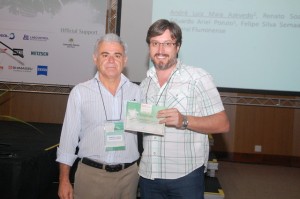
With a degree in Industrial Pharmacy at the Fluminense Federal University (UFF) and pharmacist at a multinational laboratory, André Luiz Azevedo Maia plunged in the field of Materials through his Masters degree in Chemistry, seeking to lower costs and overcome the limitations of techniques used in drug analysis. “During my career I acquired knowledge in analytical techniques that require higher spending both in the acquisition and in maintenance and operation, e.g., CLAE, GC, AA – flame and graphite furnace,” said the winner of the prize. “That motivated me to start the development of analytical techniques in Electrochemistry” he added.
André´s master thesis, supervised by Professor Felipe Silva Semaan and funded by the Rio de Janeiro State Research Foundation (FAPERJ), the Brazilian Federal Council for Scientific and Technological Development (CNPq) and UFF, was conducted between 2012 and 2014 in the Electrochemistry and Electroanalytical Group at the Institute of Chemistry, UFF, within the line of research in composite materials initiated in the group in 2009.”The use of composite materials aimed to further minimize costs for research (because there would be no need to purchase electrodes for commercial work) and opened up the possibility of developing chemical modifications and adjusting models for specific applications,” said André.
André and the research team then developed graphite and epoxy composites in various compositions, which were characterized by thermal gravimetric analysis (TGA-DTA), atomic force microscopy (AFM), X-ray diffraction (XDR) and cyclic voltammetry. One of these compositions, with 64.4% graphite, showed the best results regarding thermal and chemical stability, mechanical and electrical properties and electrochemical performance. The composite was used as an electrode in an electrochemical cell.
“In this work, the scientific contribution to society is the availability of a material with added value, with a cost about 300 times smaller than the commercial one (the glassy carbon electrode), and able to perform tasks with equivalent quality,” says André, who affirms to be attracted by the scientific activity because it offers the possibility of using tools he acquired at the university to solve problems for society.
The work presented at Symposium P on composites and advanced carbon nanostructures, deserved the Bernhard Gross Award for best poster of the XIII SBPMat Meeting, in addition to the best Poster of Symposium P. Partial results of the same research had already been distinguished in last year´s SBPMat meeting, where André received the Bernhard Gross Award for best work of the symposium on science, engineering and commercialization of industrial, electronic and biomedical devices.
André´s master degree was concluded with this highlight granted by SBPMat, but the work goes on into the group. The researchers are preparing a patent. And the results of André´s study are beeing a basis for the development of composite electrodes modified with metal films, cellulose acetate films and modified chitosan to encapsulate nanoparticles, among other studies.
“The award in this international congress rewards the effort and dedication of everyone involved and leads to further discussion, indicating the feasibility of obtaining the products targeted by the group,” said André.
See the award-winning poster file:
